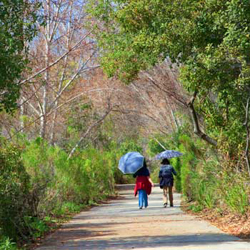Professional Practice
Adult: Type 2 Diabetes

The Centers for Disease Control and Prevention and the American Diabetes Association state that 25.8 million American adults and kids suffer from diabetes, which costs the US $176 billion in health care expenses and $69 billion in reduced productivity annually. Rates of pre-diabetes – individuals suffering from higher than normal blood glucose or A1c levels, but whose levels aren’t high enough to be diabetic – account for 35 percent of Americans ages 20 years of age and older and 50 percent of Americans 65 percent of age or older.
How Nature Helps
Research published in the journal Diabetes Care shows that walking significantly improves a person’s glycemic control and helps manage the symptoms of Type 2 Diabetes, as well as helping considerably to lessen the blood glucose levels of pre-diabetic individuals.
Further supporting this argument, A Japanese study found that diabetic patients who took forest walks of 3 to 6 kilometers exhibited consistently lower blood glucose levels. They found that the forest environment triggers changes in hormonal secretion and autonomic nervous functions that have beneficial effects on insulin sensitivity and blood glucose levels.
 ASLA 2010 Professional General Design Honor Award, The High Line, Section 1, NYC, James Corner Field Operations / Image credit: Iwan Baan
ASLA 2010 Professional General Design Honor Award, The High Line, Section 1, NYC, James Corner Field Operations / Image credit: Iwan Baan ASLA 2011 Professional Landmark Award, First San Diego River Improvement Project, San Diego, California, Wimmer Yamada and Caughey / Image credit: Kevin Walsh and Wimmer Yamada and Caughey
ASLA 2011 Professional Landmark Award, First San Diego River Improvement Project, San Diego, California, Wimmer Yamada and Caughey / Image credit: Kevin Walsh and Wimmer Yamada and CaugheyResearch
"Three 15-min Bouts of Moderate Postmeal Walking Significantly Improves 24-h Glycemic Control in Older People at Risk for Impaired Glucose Tolerance," Diabetes Care, 2013
“Exercise and Type 2 Diabetes,” Diabetes Care, 2010
“Epidemiological Evidence For The Role Of Physical Activity In Reducing Risk Of Type 2 Diabetes And Cardiovascular Disease,” Journal of Applied Physiology, 2005
"Reduction in the Incidence of Type 2 Diabetes with Lifestyle Intervention or Metformin," New England Journal of Medicine, 2002
“Shinrin-Yoku (Forest-Air Bathing And Walking) Effectively Decreases Blood Glucose Levels In Diabetic Patients,” International Journal of Biometeorology, 1998
“Physical Activity and Reduced Occurrence of Non-Insulin Dependent Diabetes Mellitus,” New England Journal of Medicine, 1991
“Blood Glucose Levels During Walking in Normal and Diabetic Subjects,”
Diabetes, 1972
Resources
"Parks are Part of Our Healthcare System," The Dirt blog
How Cities Use Parks to Improve Public Health, American Planning Association
Health Benefits of Hiking and Trails, American Hiking Society
Organizations
American Trails
The Trust for Public Land
American Community Gardening Association
Role of the Landscape Architect
Walking is one of the simplest things we can do to promote our good health. Projects like the High Line in New York, which are designed as, ultimately, long walking paths, do this well. They subtly encourage us the move through the landscape and to stay active. Once on top of the High Line, we’re drawn on to walk further, encouraged by both the beauty of the plantings and the expansive view of the city.
Landscape architects have also designed numerous walking and biking trails along the San Diego River that encourage us to be active in a beautiful riparian environment, which is likely to help us stay motivated to come back and exercise more.
Case Studies
The High Line, New York City, New York, James Corner Field Operations
First San Diego River Improvement Project, San Diego, California, Wimmer Yamada and Caughey
<< Stroke
Well-being >>